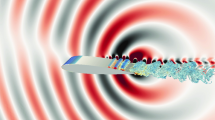Abstract
The present study focuses on the impact of grid for accurate prediction of the MEXICO rotor under stalled conditions. Two different blade mesh topologies, O and C-H meshes, and two different grid resolutions are tested for several time step sizes. The simulations are carried out using Delayed detached-eddy simulation (DDES) with two eddy viscosity RANS turbulence models, namely Spalart-Allmaras (SA) and Menter Shear stress transport (SST) k-ω. A high order spatial discretization, WENO (Weighted essentially nonoscillatory) scheme, is used in these computations. The results are validated against measurement data with regards to the sectional loads and the chordwise pressure distributions. The C-H mesh topology is observed to give the best results employing the SST k-ω turbulence model, but the computational cost is more expensive as the grid contains a wake block that increases the number of cells.
Similar content being viewed by others
References
J. Mo and Y Lee, CFD Investigation on the aerodynamic characteristics of a small-sized wind turbine of NREL PHASE VI operating with a stall-regulated method, Journal of Mechanical Science and Technology, 26 (1) (2012) 81–92.
A. Pape and J. Lecanu, 3D Navier-Stokes computations of a stall-regulated wind turbine, Wind Energy, 7 (4) (2004) 309–324.
J. Johansen, N. Sorensen, J. Michelsen and S. Schreck, Detached-eddy simulation of flow around the NREL phase VI blade, ASME 2002 Wind Energy Symposium(2002) 106–114.
P. Spalart, Detached-eddy simulation, Annual Review of Fluid Mechanics, 41 (2009) 181–202.
F. Menter and M. Kuntz, Adaptation of eddy-viscosity turbulence models to unsteady separated flow behind vehicles, The aerodynamics of heavy vehicles: trucks, buses, and trains, Springer Berlin Heidelberg(2004) 339–352.
F. Menter, Two-equation eddy-viscosity turbulence models for engineering applications, AIAA Journal, 32 (8) (1994) 1598–1605.
P. Spalart, S. Deck, M. Shur, K. Squires, M. Strelets and A. Travin, A new version of detached-eddy simulation, resistant to ambiguous grid densities, Theoretical and Computational Fluid Dynamics, 20 (3) (2006) 181–195.
K. Boorsma and J. G. Schepers, New MEXICO experiment, Technical Report, ECN Wind Energy ECN-E-14-048(2014).
M. Shur, P. Spalart, M. Strelets, A. Travin, R. Chandel and S. Bala, A hybrid RANS-LES approach with delayed-DES and wall-modelled LES capabilities, International Journal of Heat and Fluid Flow, 29 (2008) 1638–1649.
P. Spalart and S. Allmaras, A one-equation turbulence model for aerodynamic flows, La Rech. Aerospatiale, 1 (1) (1994) 5–21.
N. Kroll, C. Rossow, K. Becker and F. Thiele, The Megaflow project, Aerospace Science and Technology, 4 (4) (2000) 223–237.
T. Lutz, K. Meister and E. Krämer, Near wake studies of the MEXICO rotor, European Wind Energy Association, Brüssel(2011).
G. Bangga, Y. Kim, T. Lutz, P. Weihing and E. Krämer, Investigations of the inflow turbulence effect on rotational augmentation by means of CFD, Journal of Physics: Conference Series, 753 (2) (2016) 022026.
P. Weihing, J. Letzgus, G. Bangga, T. Lutz and E. Krämer, Hybrid RANS/LES capabilities of the flow solver FLOWer -application to flow around wind turbines, The 6th Symposium on Hybrid RANS-LES Methods, Strassbourg, France(2016).
X. Liu, S. Osher and T. Chan, Weighted essentially nonoscillatory schemes, J. Comput. Phys., 115 (1994) 200–212.
U. Kowarsch, C. Oehrle, M. Keßler and E. Krämer, High order CFD-simulation of the rotor fuselage interaction, 39th European Rotorcraft Forum, Moscow(2013).
A. Jameson, Time dependent calculations using multigrid, with applications to unsteady flows past airfoils and wings, AIAA paper 1991 (1991) 1596.
B. Kim, W. Kim, S. Bae, J. Park and M. Kim, Aerodynamic design and performance analysis of multi-MW class wind turbine blade, Journal of Mechanical Science and Technology, 25 (8) (2011)1995–2002.
G. Bangga, G. Hutomo, R. Wiranegara and H. Sasongko, Numerical study on a single bladed vertical axis wind turbine under dynamic stall, Journal of Mechanical Science and Technology, 31 (1) (2017) 261–267.
G. Bangga and H. Sasongko, Dynamic stall prediction of a pitching airfoil using an adjusted two-equation URANS turbulence model, Journal of Applied Fluid Mechanics, 10 (1) (2017) 1–10.
Author information
Authors and Affiliations
Corresponding author
Additional information
Recommended by Associate Editor Donghyun You
Galih Bangga is currently working as a Researcher at the Institute of Aerodynamics and Gas Dynamics, University of Stuttgart, Germany. His research interests include wind turbine aerodynamics, flow separation and airfoil design.
Rights and permissions
About this article
Cite this article
Bangga, G., Weihing, P., Lutz, T. et al. Effect of computational grid on accurate prediction of a wind turbine rotor using delayed detached-eddy simulations. J Mech Sci Technol 31, 2359–2364 (2017). https://doi.org/10.1007/s12206-017-0432-6
Received:
Revised:
Accepted:
Published:
Issue Date:
DOI: https://doi.org/10.1007/s12206-017-0432-6




